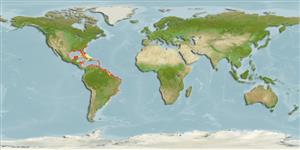(كوسه ها و سپرماهيان) (sharks and rays) >
Torpediniformes (Electric rays) >
Narcinidae (Numbfishes)
Etymology: Narcine: Greek, narke = numbness (Ref. 45335).
Environment: milieu / climate zone / depth range / distribution range
بوم شناسي
دريايي وابسته به آب سنگ; تغييرات عمق 1 - 43 m (Ref. 13608). Subtropical; 37°N - 39°S, 98°W - 34°W
Western Atlantic: Espirito Santo, Brazil to northern Argentina (Carvalho, pers. comm.). North Carolina, USA to Florida, northern Gulf of Mexico, central Lesser Antilles and Yucatan (Ref. 26938).
Length at first maturity / Size / Weight / سن
Maturity: Lm 28.8 range ? - ? cm
Max length : 54.0 cm WD جنس نر / بدون خواص جنسي; (Ref. 26340); common length : 35.0 cm WD جنس نر / بدون خواص جنسي; (Ref. 5217); بيشينه وزن گزارش شده: 650.00 g (Ref. 6902)
توصيف مختصر
كليدهاي شناسايي | ريخت شناسي | ريخت ستجي بوسيله انداره گيري
A pale sand-colored ray, often with ellipses of dark spots on dorsal side of rounded disk (Ref. 26938). Grayish to reddish brown, many rounded blotches outlined with blackish spots. Dark bands across tail up to dorsal fin. Snout darkened (Ref. 7251).
Inhabits coastal waters, on sand or mud bottoms (Ref. 26340). Common along sandy shorelines, sometimes near coral reefs (Ref. 12951). Aggregates in shallow waters ca. 10-20 m deep during summer and autumn months, dispersing to deeper waters during winter (Ref. 114953). Buries itself with only eyes protruding (Ref. 12951). Nocturnal, moves to shallow bays at night to feed; prefers worms, but may take juvenile snake eels, anemones, and, small crustaceans (Ref. 12951). Produces broods of 4 to 15 young (Ref. 26938). Reaches ca. 45 cm TL. Both sexes mature by 27 cm TL; birth size at ca. 11 cm TL (Ref. 114953). Can discharge between 14 and 37 volts. Contact with the skin can produce a severe electric shock. In addition to the main electric organ, this species possesses a bilateral accessory electric organ (Ref. 10011) speculated to have a possible role in social communication (Ref. 10489). Reported to taste good, but not fished commercially. Traded as an aquarium fish at Ceará, Brazil (Ref. 49392).
Life cycle and mating behavior
Maturities | تولید مثل | Spawnings | Egg(s) | Fecundities | توزاد ( لارو)
Ovoviviparous. Sex ratio of embryos is about one to one, however, small mothers may have predominantly female embryos and that for a given mother, embryos tend to be of one sex (Ref. 46979). Maximum number of embryos per female may reach 15. The young are capable of giving off electric charges even before they are released from the womb (Ref. 46978).
Robins, C.R. and G.C. Ray, 1986. A field guide to Atlantic coast fishes of North America. Houghton Mifflin Company, Boston, U.S.A. 354 p. (Ref. 7251)
وضعيت در فهرست قرمز IUCN (Ref. 130435)
استفاده انسانی
ماهي گيري – شيلات: معاش ماهیگیری; آكواريوم: تجاري
ابزارها
گزارش های ويژه
بارگيری XML
منابع اينترنتي
Estimates based on models
Preferred temperature (Ref.
123201): 22.9 - 28, mean 25.6 °C (based on 442 cells).
Phylogenetic diversity index (Ref.
82804): PD
50 = 0.5000 [Uniqueness, from 0.5 = low to 2.0 = high].
Bayesian length-weight: a=0.01122 (0.00605 - 0.02082), b=2.90 (2.73 - 3.07), in cm total length, based on LWR estimates for this species & (Sub)family-body (Ref.
93245).
Trophic level (Ref.
69278): 3.2 ±0.4 se; based on diet studies.
جهندگی (Ref.
120179): پايين ، كم, كمينه زمان لازم براي دو برابر شدن جمعيت 5/4 – 14 سال (Assuming fecundity<100).
Fishing Vulnerability (Ref.
59153): Low to moderate vulnerability (34 of 100).
Nutrients (Ref.
124155): Calcium = 6.47 [0.67, 106.25] mg/100g; Iron = 0.472 [0.039, 5.319] mg/100g; Protein = 16.6 [12.4, 21.0] %; Omega3 = 0.145 [0.049, 0.421] g/100g; Selenium = 14.3 [2.3, 70.5] μg/100g; VitaminA = 22.2 [1.8, 283.1] μg/100g; Zinc = 0.82 [0.06, 9.22] mg/100g (wet weight);
